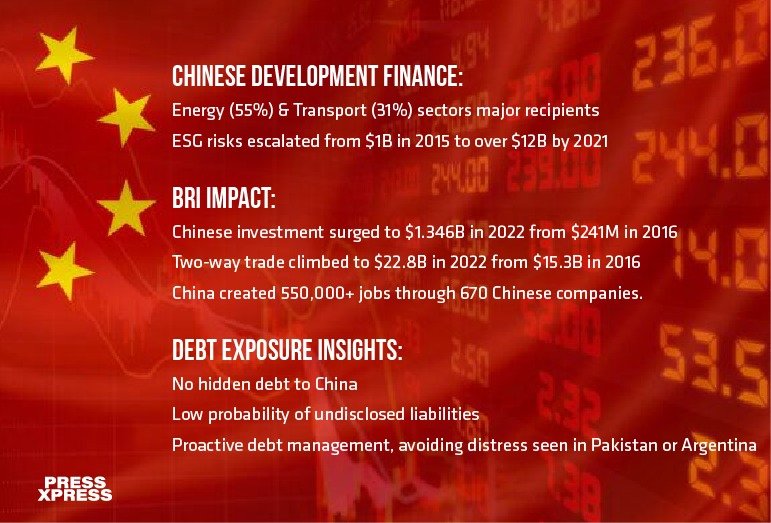Bangladesh does not have any hidden debt exposure to China, showing the likelihood of unaccounted for (or implicit) liabilities on the government of Bangladesh to Chinese official sector lenders is low,” AidData said
Amidst the evolving global power play, Bangladesh emerges as a pivotal battleground for great power competition, marked by its strategic location and the surge of Chinese investment under the Belt and Road Initiative (BRI). The recent analysis by AidData, an influential US-based research lab, forecasts the country’s continued significance in the geopolitical theater. The study report was released on Monday (6th November 2023).
AidData, hosted at William & Mary’s Global Research Institute, delves into the intricacies of Chinese investment within Bangladesh’s BRI participation. The report’s findings forecast Bangladesh’s enduring role as a crucible for power dynamics due to its unique geostrategic position and evolving global trends.
This report coincides with Beijing commemorating the 10th anniversary of President Xi Jinping’s notable initiative. Notably, Bangladesh was the initial South Asian nation to align with the BRI back in 2016.
Chinese Financing’s Impact on Bangladesh
AidData’s analysis revealed that within the total Chinese development finance committed to Bangladesh between 2000 and 2021, $20.79 billion, 19% comprised ODA (grants and highly concessional loans) while 81% constituted OOF (other official sector loans).
In contrast to the $175 million annual average during the BNP era (2002-06), Chinese development funding escalated to $381 million annually during Sheikh Hasina’s initial term (2009-14). Subsequently, it soared to $2.2 billion (2014-2018) and further to $2.3 billion (2019-present), marking a seven-fold increase.
Interestingly, the research lab didn’t identify any undisclosed debt exposure of Bangladesh to China, indicating a low probability of unreported liabilities owed by the Bangladeshi government to Chinese official lenders.

According to the report, Bangladesh’s strategic location and recent shifts in global politics—such as India’s ascent and escalating Sino-US tensions in the South China Sea—indicate its enduring role as a pivotal arena for major power rivalry in the foreseeable future.
From Dhaka’s viewpoint, the mounting competition between China and the US in the Indo-Pacific region presents avenues for bolstering economic advancement. Bangladesh, with its economy still reliant on its predominant textile industry, sees potential in diversification through the development of competitive sectors adjacent to it.
Achieving this diversification necessitates investments, knowledge transfer, and deeper integration of existing industries into global supply chains. According to assessments, forging stronger trade ties with China, possibly facilitated by the proposed rail link through Myanmar, could usher in economic growth by generating employment opportunities.
Meanwhile, from the US perspective, leveraging its robust trade relations with Bangladesh and its strong alliance with India—Bangladesh’s most influential regional partner—could offer pathways to expand influence in the region.
China’s BRI Impact: Aid Surge in Bangladesh
During the initial phase of the Belt and Road Initiative (BRI), there was a significant surge in China’s aid and credit provisions to Bangladesh. Between 2014 and 2017, the average yearly commitments of ODA (Official development assistance) and OOF (Other official flows) from China to Bangladesh stood at a modest $994 million. However, during the later phase of the BRI, from 2018 to 2021, this number escalated dramatically to $3.4 billion.
AidData summarized this unprecedented surge in spending, noting that it aligned with a phase of political stability, notably after Prime Minister Sheikh Hasina secured her second consecutive electoral victory in 2018. This period coincided with a discernible rise in authoritarian tendencies as well.
Anticipating Prime Minister Sheikh Hasina’s victory in the forthcoming 2024 election, the study reinforces the continuation of her leadership, a crucial factor in shaping Bangladesh’s trajectory in global dynamics. Her leadership tenure has seen substantial economic growth and strategic alliances, positioning Bangladesh as a noteworthy player on the global stage.

Bangladesh’s $17.1B Debt Exposure to China
Bangladesh’s debt exposure to China stands at $17.1 billion, accounting for 4.1% of its GDP, notably 6.9 percentage points below the global average in China’s portfolio. AidData highlights that Bangladesh lacks hidden debt to China, indicating a low probability of undisclosed liabilities to Chinese official lenders. This proactive debt management, unlike cases in Pakistan or Argentina, suggests Bangladesh has avoided debt distress.
However, 59% of projects face ESG risks, particularly in the energy sector, where financed coal-fired power plants raise concerns. Just a quarter of the portfolio is safeguarded by robust ESG contracts, signaling potential implementation challenges ahead.


